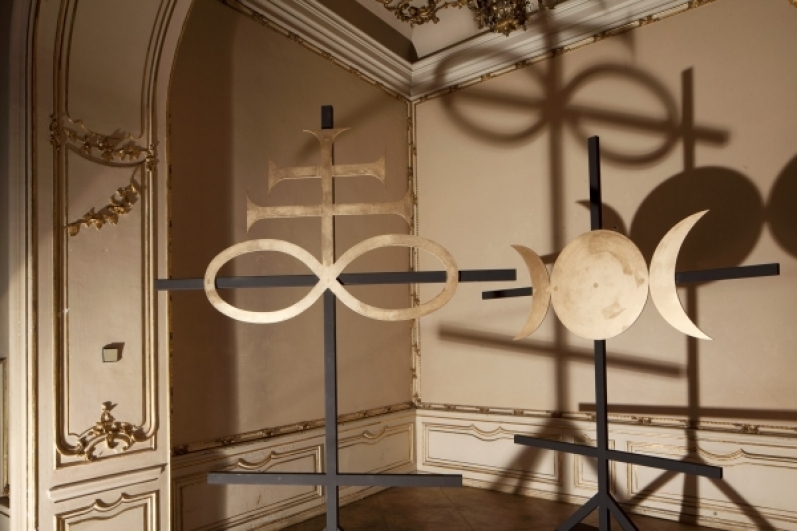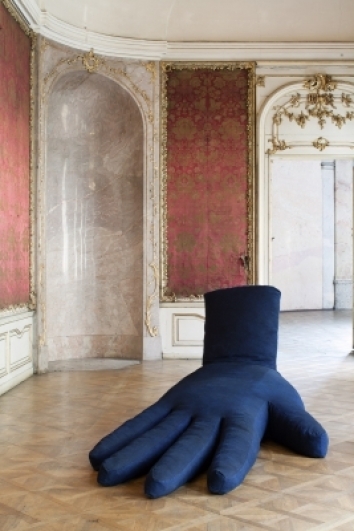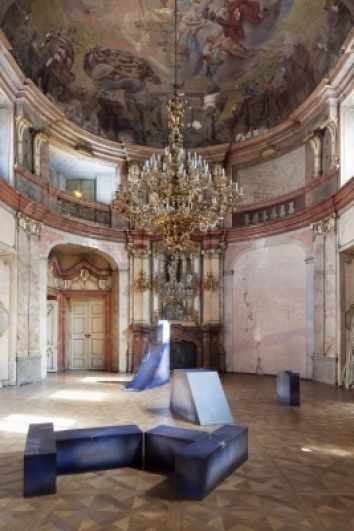intervention_3 Anežka Hošková, Jakub Hošek, Nik Timková SUPERIMPOSITIONS 1. 4. 2015 – 31. 5. 2015
The brother-sister artist duo Jakub Hošek and Anežka Hošková together with Nik Timková embody the English phrase which is often used by marketing departments of film studios: expect the unexpected. They live in constant motion, traveling – especially Jakub and Nik – between their various places of residence in international cities, often going directly from the studio to concerts which they organize together with Štěpán Bolf, brother of the painter Josef Bolf, as the A.M.180 Collective. They often do not show up in time (or at all) at an agreed meeting, but their work presented at exhibitions is perfect.
All of them are significant drivers of local visual culture and they stand out in the local community of artists. They widely share their concept of the aesthetics and the mix of subcultures, in which they are interested, with the other people on social networks, in their production and at music events.
When you meet them in the street, based on fashion creations you might think that you have met a cosplay from a manga comic cartoon. A.M.180’s musical events, primarily the Creepy Teepee Festival in Kutná Hora, have for a long term presented new projects and bands, from which world stars may arise in a couple of years. Let us remember the concert of Future Islands at Club 007 in Strahov five years ago where they played for 50 people. Following their last year’s album Singles and their appearance on the David Letterman talk show they have suddenly become world-renowned musicians who go on tour with an endless string of sold-out concerts, including their last year’s performance at the Lucerna Music Bar in Prague.
They are genuine trendsetters. They relentlessly bring about world culture in real time to the sleepy Czech lands which chronically lag behind. However, it is interesting to watch how few people are interested in it at the given moment and how they are able to accept it only with a delay through online or printed media. Instead, a certain stereotype has been created as regards the perception of this trio, as evidenced by television programmers and filmmakers who under pressure are trying to define them as hipsters without knowing that they behave this way naturally and not since the term hipster has arrived to the Czech lands about two years after it was already out in the world.
In recent years the artists have expanded their existing manifestos by the post-Internet aesthetics. They have begun to project mechanisms and simple imagination known from the computer environment and the web, as can be seen in Intervention 3 of Superimpositions at the Colloredo-Mansfeld Palace where they have prepared a series of disparate objects presenting the current stage of artistic development of each of them. At the same time they have not lost anything from their playfulness and irony, which make them different from the ubiquitous contemplative, serious and sophisticated approach to art.
The term Superimpositions, originally the title of a soundtrack and album by the Milano musician Lorenzo Senni, refers to a technique in which a layer is imposed on the existing surface. It is used as a term for intervention of objects overlaying the piano nobile of the Colloredo-Mansfeld Palace and as an expression of their layering related more to the technique rather than to the content.
Anežka Hošková is a master of styling. Her propensity for self-stylization employing a deep irony and fantasy can be seen from the very beginning of her entrée into the Czech art scene.
During her studies at Václav Stratil’s Department at the Brno Faculty of Fine Arts she created surreal paintings and drawings of animals and figural motifs with distinct contours, very close by their schematic nature to comic cartoons, which is a feature she has in common with Jakub. At that time already Anežka worked with grim themes such as the motif of death and symbols of darkness and magic accompanied by a slight dose of irony. One of the main sources of inspiration for her was the literary oeuvre of Sylvia Plath, after whose poems Anežka entitled her works of art.
Her paintings slowly began to incorporate the watercolor technique, and its vague character further enhanced the dreamy atmosphere of the scenes (the series They Came from the Stars I Saw Them, 2009). Thanks to watercolor, Anežka’s brushwork became more relaxed, the image acquired a new depth and became reduced in a new way. This is apparent, for example, in canvases used by Anežka for her performances within the series Analog Witch. There were two performances in Prague, the first at the group exhibition “She Wolf of the Night II – Winter, Karlin Studios”, the second one at the Futura gallery at the exhibition “Graphic Design” (both exhibitions took place in 2014).
For Anežka, performances are a logical outcome of her installations, and it is interesting that the above-mentioned paintings represent a kind of screenplay for the performances. During the performances Anežka acts as an immoral goddess, personifying a fantastic magical creature using sexuality and sensuality to emphasize things, her own emotions. The performances take a long time – they last approximately 2–3 hours and place high demands on the viewer, for whom the action may become a really boring affair in the end. In the case of Analog Witch, the only thing to be seen was her head peeking out from the middle of a table with braided hair as a symbol of the severed head of mythical Medusa, which Anežka would like to become. Anežka designs tools for her actions such as liturgical vestments, tabernacles and, as the case may be, things for the altar. She works with symbols of different religions and cultures.
For Superimpositions Anežka has created two majestic objects with the structure of a double cross with massive gold-colored symbols, which feature in the exhibition on their own. One bears the emblem of Wicca, the goddess of the modern religion (successor to the pagan cults) – the ornament of a moon with crescents of the new moon and the old moon adjacent to both sides; the other is a combination of the horizontal eight (infinity) and a patriarchal cross. On Friday, 1 May, Anežka will make a performance near these objects to the accompaniment of a concert of King Dude.
Nik Timková joined the Hošek siblings within the framework of their artistic collaboration as well as thanks to her relationship with Jakub (to put it bluntly in order to avoid possible hypotheses in this direction). Nik is a little younger than Anežka and Jakub and belongs to the generation of digital natives. She has combined the virtual world with the real one more naturally than the Hošeks. In her oeuvre an important role is played by the above-mentioned post-Internet aesthetics with a focus on the structure of the material. She is also keen on skin-colored makeup, and her complete obsession is a coconut, its hidden fluid.
The theoretical part of her thesis (Il est mort le soleil, 2010) was based on the study of Neo-Gothic art as presented in the book New Gothic Art by the curator Francesca Gavin. Nik further developed this topic in her studies at the Saint Martin College in London for the master’s degree, where her dissertation (Forest Folklore, 2011) closed for a certain time her period of black “VRUSK”.
Recently Nik deals with the deconstruction of clothing in art. She applies her theoretical research to the curatorial project #Cut Club whose offline version can be seen in the AM180 Gallery. It is connected with the interventions in the Colloredo-Mansfeld Palace – the tailor-made oversized hand severed at the wrist. Nik develops her previous work done in Stockholm called Existential Housekeeping # 1, where she analyzed clothing and its social and formal structure through the contemporary post-Internet reality. A part of the installation consisted of a suspended blew out hand, the prototype of which can be found in the work of the fashion designer Jean-Charles de Castelbajac. The new version of the hand, made of denim with the color changed by batik and padded with foam, is a direct appropriation of The Red Foot (1967-1968) by the female artist Nicola L.
Jakub Hošek studied at the Academy of Fine Arts in 1998 at the Department of Vladimír Skrepl and Jiří Kovanda. He got there symbolically “by accident” when he arrived late for the entrance exam to study under Vladimír Kokolia and was sent to another Vladimír.
During the first years of his studies Jakub did not find too many fans of his work among teachers. The situation changed with his determination to transfer the technique of drawing into painting. After several unsuccessful attempts with the brush Jakub concluded that he would achieve the character of drawing most closely by using templates, which he would trace and subsequently transfer the exact shape to the canvas where he would paint it. At that time he developed his own work process, one of his specific artistic features, which he has exploited up to this day.
All positions of Jakub’s painting represent the conceptual thought. And it does not matter whether the painting leaves the conformity of the 2D frame and settles on a 3D object. In the long term it is a systematically concentrated statement synthesized from various sources of Jakub’s past – LP covers, squat and punk of the 1990s, New York painting of the 1980s, works by New Surrealists, literature and film. Sometimes, for example, Jakub encrypts the name of one of his favorite female artists, actresses or porn stars in his painting. He works with the image using the principle of collage and printmaking techniques, putting one layer over another; in his work he has so far managed to avoid stereotypes.
Objects which Jakub placed in the Colloredo-Mansfeld Palace are based on a designed shape and consist of a series of signs (such as the letter I, spatial trapezoid and U-ramp), where drawing comes second, making an intervention in the objects. The form and surface are treated masterfully; the objects look elegant. An analogy can be seen in the memphist, a trend in the design of the 1980s when Modern Art was undermined by means of irony, by piling basic forms on top of each other and denying their material.
More abstract drawing brings about lighter expression to the objects accompanied by words such as The Unfinished and Applause. The intervention of the objects into the historic area is unexpectedly graceful. The objects do not disturb, but resonate. Despite their scale they act as a miniature version of something much more impressive and spectacular.
Monika Doležalová



